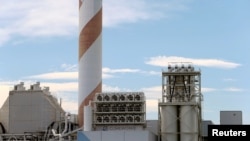With climate-changing emissions still inching higher — and resulting threats from extreme weather surging — sucking greenhouse gases out of the atmosphere must become an urgent priority, backers of "carbon removal" efforts say.
"The math is quite simple," Manish Bapna, executive vice president of the Washington-based World Resources Institute, told a panel discussion on the fledgling approach this week.
If the world overshoots the temperature goals set in the 2015 Paris Agreement on climate change, as looks increasingly likely, "carbon removal gets us back on track," he said.
"The first imperative is to reduce emissions as quickly and deeply as possible," Bapna said. "But there is now a second imperative... to remove carbon dioxide from the atmosphere at a large scale."
Proposals to suck carbon out of the atmosphere range from planting many more trees, which absorb carbon dioxide to grow, to installing devices that capture carbon directly from the air.
Changing farming practices to store more carbon in soils, or producing energy by growing trees or crops, burning them and pumping underground the carbon released also could play a role, scientists say.
Interest in carbon removal technologies is growing, not least because countries from Britain to the United States have included some of them in their plans to curb climate change.
They also feature in a report, due out next month, by the world's leading climate scientists, who say governments may have to find ways to extract vast amounts of carbon from the air if warming overshoots the lower Paris pact limit of 1.5 degrees Celsius (2.7 Fahrenheit). That overshoot is expected to happen by about 2040, according to a draft copy of the report.
"Carbon removal is really about creating options," said Kelly Levin, a senior associate at the World Resources Institute. "If you fast forward 20 or 30 years, we want to keep options open."
Growing urgency
The surging scale of losses to extreme weather — including the storms that smashed into the eastern United States and the Philippines this month — means more people now believe climate change needs to be curbed, said Klaus Lackner, director of the U.S.-based Center for Negative Carbon Emissions.
"I believe we are at a turning point where people are starting to see the problem needs to be solved," said Lackner, a proponent of technology to capture carbon from the air.
Right now, the costs of carbon removal may be too high but as climate impacts worsen "eventually it will hurt, and then we will pay whatever it takes," he predicted.
"Show me technologies that didn't get six times cheaper in a decade when they were actually used," he added.
Carbon removal faces many other challenges including low government spending, competition for land, and a need to move faster than finance and technology may allow, experts admitted.
For instance, capturing carbon dioxide directly from the air, while possible, also requires a lot of energy, said James Mulligan, a World Resources Institute researcher on carbon removal.
Capturing just 15 percent of U.S. annual emissions would use 7 percent of projected U.S. energy production in 2050, he said.
Avoiding the worst
Farming differently to store more carbon in soils, by comparison, could be cheaper and provide extra benefits, boosting harvests, water conservation and wildlife habitats, said Betsy Taylor, president of consulting firm Breakthrough Strategies and Solutions.
"This pathway is the most affordable, technologically ready and it is a no-regrets option," particularly as about a third of the world's soils are now considered degraded, she said.
Experimenting with carbon removal deserves "a newfound sense of urgency" not least because more intrusive "geoengineering" ideas, such as blocking some of the sun's rays from reaching the planet, are "coming down the pike," she said.
But getting millions of farmers and ranchers to alter how they work would require significant investment — and monitoring carbon reductions from soil use remains an inexact science, experts admitted.
Most carbon removal technologies would get the world only a fraction of the way to solving its climate problem, they said — and the prospect of having the technologies available might be seized as an excuse to stall action to cut emissions.
"We need to be clear-eyed about the challenges," Mulligan said.
The key, said Levin of the World Resources Institute, is ensuring both emissions cuts and carbon removal efforts move ahead fast enough to ward off the worst anticipated impacts of climate change, from worsening hunger to extreme heatwaves.
"If you look at the science, we have to pull out all the stops on mitigation and carbon removal at a scale that is completely unprecedented," she said.









